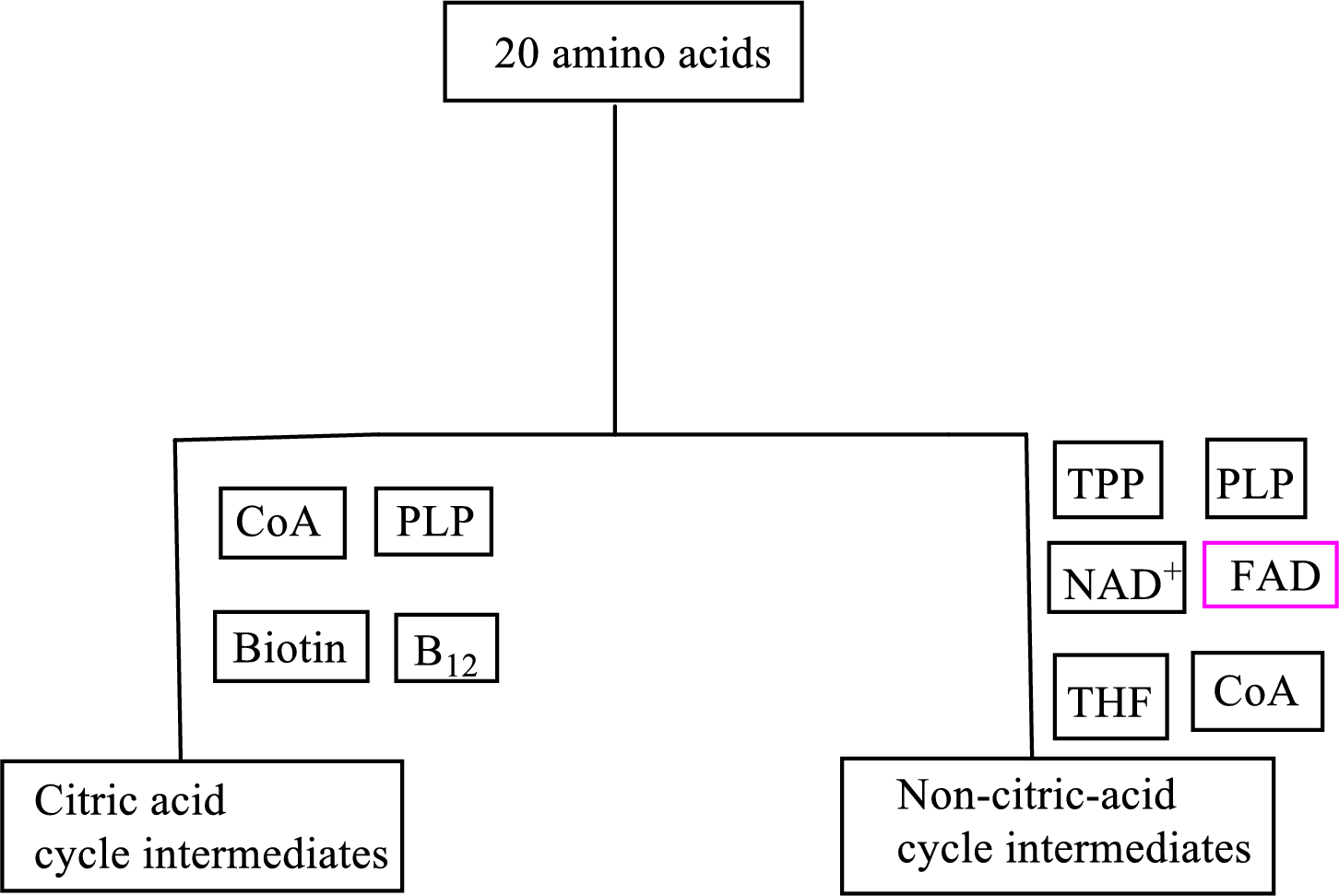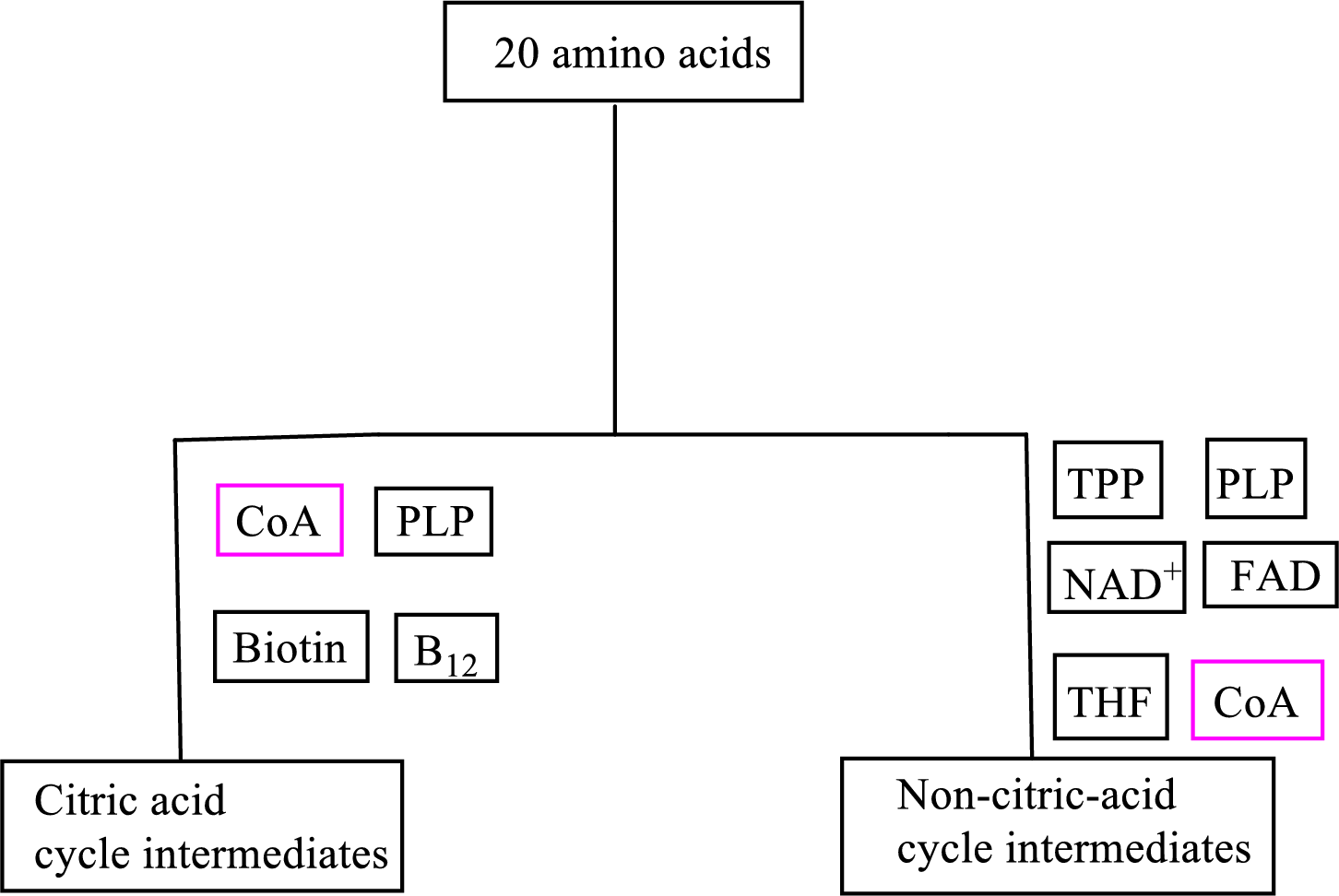
Concept explainers
(a)
Interpretation:
To indicate whether B vitamin riboflavin is involved as a cofactor in the processes of (1) transamination, (2) oxidative deamination, (3) urea cycle, (4) carbon skeleton degradation to CAC intermediates, or (5) carbon skeleton degradation to non-CAC intermediates.
Concept introduction:
Cofactors are non-protein organic compounds that are used along with the enzymes and help to carry forward the reaction. The coenzymes containing B-vitamin serve as temporary carriers of atoms or
Transamination reaction is a biochemical reaction that involves the transfer of an amino group. In transamination reaction exchange of an amino group from an
A biochemical reaction in which an
A urea cycle is a cyclic biochemical pathway that involves the production of urea using ammonium ions and aspartate molecules as nitrogen sources. The reactants in the formation of carbamoyl phosphate are ammonium ion, water, and carbon dioxide. The desired product of the urea cycle is urea.
There are 20 standard amino acids. Each amino acid has a different carbon skeleton and has a different degradation pathway for its carbon skeleton.
(a)
Answer to Problem 26.116EP
B vitamin riboflavin is involved as a cofactor in carbon skeleton degradation to non-CAC intermediates.
Explanation of Solution
Coenzyme flavin adenine dinucleotide
Flavin adenine dinucleotide

(b)
Interpretation:
To indicate whether B vitamin thiamin is involved as a cofactor in the processes of (1) transamination, (2) oxidative deamination, (3) urea cycle, (4) carbon skeleton degradation to CAC intermediates, or (5) carbon skeleton degradation to non-CAC intermediates.
Concept introduction:
Cofactors are non-protein organic compounds that are used along with the enzymes and help to carry forward the reaction. The coenzymes containing B-vitamin serve as temporary carriers of atoms or functional groups in the redox and group transfer reactions associated with the metabolism of ingested food in order to obtain energy from the food.
Transamination reaction is a biochemical reaction that involves the transfer of an amino group. In transamination reaction exchange of an amino group from an
A biochemical reaction in which an
A urea cycle is a cyclic biochemical pathway that involves the production of urea using ammonium ions and aspartate molecules as nitrogen sources. The reactants in the formation of carbamoyl phosphate are ammonium ion, water, and carbon dioxide. The desired product of the urea cycle is urea.
There are 20 standard amino acids. Each amino acid has a different carbon skeleton and has a different degradation pathway for its carbon skeleton.
(b)
Answer to Problem 26.116EP
B vitamin thiamin is involved as a cofactor in carbon skeleton degradation to non-CAC intermediates.
Explanation of Solution
Coenzyme thiamin pyrophosphate
Thiamin pyrophosphate

(c)
Interpretation:
To indicate whether B vitamin pantothenic is involved as a cofactor in the processes of (1) transamination, (2) oxidative deamination, (3) urea cycle, (4) carbon skeleton degradation to CAC intermediates, or (5) carbon skeleton degradation to non-CAC intermediates.
Concept introduction:
Cofactors are non-protein organic compounds that are used along with the enzymes and help to carry forward the reaction. The coenzymes containing B-vitamin serve as temporary carriers of atoms or functional groups in the redox and group transfer reactions associated with the metabolism of ingested food in order to obtain energy from the food.
Transamination reaction is a biochemical reaction that involves the transfer of an amino group. In transamination reaction exchange of an amino group from an
A biochemical reaction in which an
A urea cycle is a cyclic biochemical pathway that involves the production of urea using ammonium ions and aspartate molecules as nitrogen sources. The reactants in the formation of carbamoyl phosphate are ammonium ion, water, and carbon dioxide. The desired product of the urea cycle is urea.
There are 20 standard amino acids. Each amino acid has a different carbon skeleton and has a different degradation pathway for its carbon skeleton.
(c)
Answer to Problem 26.116EP
B vitamin pantothenic acid is involved as a cofactor in carbon skeleton degradation to non-CAC and CAC intermediates.
Explanation of Solution
Coenzyme A
Coenzyme A

(d)
Interpretation:
To indicate whether B vitamin
Concept introduction:
Cofactors are non-protein organic compounds that are used along with the enzymes and help to carry forward the reaction. The coenzymes containing B-vitamin serve as temporary carriers of atoms or functional groups in the redox and group transfer reactions associated with the metabolism of ingested food in order to obtain energy from the food.
Transamination reaction is a biochemical reaction that involves the transfer of an amino group. In transamination reaction exchange of an amino group from an
A biochemical reaction in which an
A urea cycle is a cyclic biochemical pathway that involves the production of urea using ammonium ions and aspartate molecules as nitrogen sources. The reactants in the formation of carbamoyl phosphate are ammonium ion, water, and carbon dioxide. The desired product of the urea cycle is urea.
There are 20 standard amino acids. Each amino acid has a different carbon skeleton and has a different degradation pathway for its carbon skeleton.
(d)
Answer to Problem 26.116EP
Explanation of Solution
Coenzyme methylcobalamin contains the B vitamin
Coenzyme methylcobalamin is involved in the carbon skeleton degradation pathway to CAC intermediates.
An overview of the B vitamin participations in the degradation pathways for the carbon skeletons of the 20 standard amino acids is as follows:

Want to see more full solutions like this?
Chapter 26 Solutions
EBK GENERAL, ORGANIC, AND BIOLOGICAL CH
- A. Draw the structure of pyruvate at plI 7. B.Explain why pyruvate is considered anα-ketoacid. C.arrow_forwardDefine the following terms: a. thiolytic cleavage b. ketogenesis c. ketone bodies d. α-oxidation e. ACCarrow_forwardAn infant with corneal clouding has dermatan sulfate and heparan sulfate in his urine. Decreased activity of which of the enzymes listed below would confirm the suspected diagnosis of Hurler syndrome? * A. α-Glucuronidase B. Glycosyltransferase C. α-L-Iduronidase D. Iduronate sulfatase E. None of the given optionsarrow_forward
- A. List all the materials required for beta-oxidation of fatty acids. How does this process differ from the Biosynthesis of fatty acids? B. Outline the pathway involved in the synthesis of cholesterol from six-carbon intermediate Mevalonate. C. Describe all the stages involved in the urea cycle (Transmination, Ammonia Transport, and stages of the urea cycle).arrow_forward8. In patients after prolonged hepatitis, the ALT and AST activities were measured in the blood serum. What transaminase activity is inereased to a greater extent, and why? For the answer: a) explain the meaning of the enzyme diagnostics; b) draw the scheme of reactions catalyzed by ALT and AST; c) point out coenzyme of these reactions; describe vitamin from which this cocnzyme is derived; d) describe the biological importance of this type of reactions in amino acid metabolism; e) specify the demands which are claimed to enzymes been used in enzyme diagnostics.arrow_forwardAlpha-glucosidase inhibitors are contraindicated in all of the following cases, except:A. Diabetic ketoacidosisA. Liver cirrhosisB. HypertensionC. Large abdominal herniasD. Ulcerative colitisarrow_forward
- Explain how the prolong intake of antacids can lead to vitamin B12 deficiency?arrow_forward1) Discuss recent findings on the effects of consumption of cholesterol and saturated, polyunsaturated, and monounsaturated fats. Give examples of each type of fat. 2) We often think only of DNA and RNA as nucleic acids. Discuss the role of other, less “well-known” nucleic acids, such as cAMP, cGMP, NADH, NADPH, and FADH. 3) Collagen is a very important structural protein in animals. Discuss the various parts of the body in which collagen is an important structural molecule and what its function is at each body location.arrow_forward10. Answer ALL parts of this question. Prostaglandin-endoperoxide synthase 2, also known as cyclooxygenase- 2 or COX-2, is an enzyme that in humans is encoded by the PTGS2 gene. (a) Explain how this enzyme facilitates prostaglandin biosynthesis by highlighting two key functions. (b) Describe one role for the COX-1 enzyme. (c) Name one condition that the selective COX-2 inhibitors Vioxx (Rofecoxib) and Celebrex (Celecoxib) were used to treat. (d) Name and draw the chemical structures of 4 other small molecule OCOX-2 inhibitors and identify 3 similarities/common features with respect to Rofecoxib and Celecoxib. (e) Name a therapeutic reason for targeting COX-3. Describe the function and therapeutic utility of non-steroidal anti- (f) inflammatory drugs.arrow_forward
- 1. Discuss why a saturated fatty acid like lauric acid has a good anti-oxidant property. 2. Why are the essential fatty acid associated with low incidence of heart disease? Cite some clinical signs of essential fatty acid deficiency. 3. Explain how aspirin can block the synthesis of prostaglandins?arrow_forwardIn healthy adults, the concentration of glucose in blood is approximately80 to 110 milligrams per deciliter (mg/dl). After a carbohydrate-richmeal, however, the concentration may spike to 140 mg/dl. Describe thehormonal action that returns blood glucose to normal.arrow_forwardFrom the three figures below, indicate which represents best the catalytic pocket of trypsin, a serine protease, secreted by acinar pancreatic cells. C) A) A. Figure A. B.Figure B. ⒸC. Figure C. Asp 189 B) Asp 189 Val 190 Val 216 work of Val 216 Val 190arrow_forward
 Human Anatomy & Physiology (11th Edition)BiologyISBN:9780134580999Author:Elaine N. Marieb, Katja N. HoehnPublisher:PEARSON
Human Anatomy & Physiology (11th Edition)BiologyISBN:9780134580999Author:Elaine N. Marieb, Katja N. HoehnPublisher:PEARSON Biology 2eBiologyISBN:9781947172517Author:Matthew Douglas, Jung Choi, Mary Ann ClarkPublisher:OpenStax
Biology 2eBiologyISBN:9781947172517Author:Matthew Douglas, Jung Choi, Mary Ann ClarkPublisher:OpenStax Anatomy & PhysiologyBiologyISBN:9781259398629Author:McKinley, Michael P., O'loughlin, Valerie Dean, Bidle, Theresa StouterPublisher:Mcgraw Hill Education,
Anatomy & PhysiologyBiologyISBN:9781259398629Author:McKinley, Michael P., O'loughlin, Valerie Dean, Bidle, Theresa StouterPublisher:Mcgraw Hill Education, Molecular Biology of the Cell (Sixth Edition)BiologyISBN:9780815344322Author:Bruce Alberts, Alexander D. Johnson, Julian Lewis, David Morgan, Martin Raff, Keith Roberts, Peter WalterPublisher:W. W. Norton & Company
Molecular Biology of the Cell (Sixth Edition)BiologyISBN:9780815344322Author:Bruce Alberts, Alexander D. Johnson, Julian Lewis, David Morgan, Martin Raff, Keith Roberts, Peter WalterPublisher:W. W. Norton & Company Laboratory Manual For Human Anatomy & PhysiologyBiologyISBN:9781260159363Author:Martin, Terry R., Prentice-craver, CynthiaPublisher:McGraw-Hill Publishing Co.
Laboratory Manual For Human Anatomy & PhysiologyBiologyISBN:9781260159363Author:Martin, Terry R., Prentice-craver, CynthiaPublisher:McGraw-Hill Publishing Co. Inquiry Into Life (16th Edition)BiologyISBN:9781260231700Author:Sylvia S. Mader, Michael WindelspechtPublisher:McGraw Hill Education
Inquiry Into Life (16th Edition)BiologyISBN:9781260231700Author:Sylvia S. Mader, Michael WindelspechtPublisher:McGraw Hill Education





